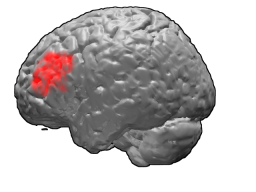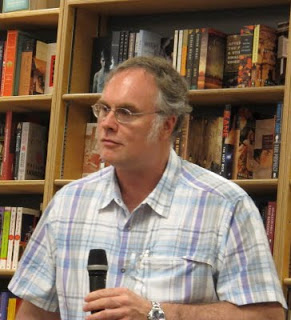
Transcranial magnetic stimulation (TMS) is a noninvasive form of brain stimulation in which a changing magnetic field is used to induce an electric current at a specific area of the brain through electromagnetic induction. An electric pulse generator, or stimulator, is connected to a magnetic coil connected to the scalp. The stimulator generates a changing electric current within the coil which creates a varying magnetic field, inducing a current within a region in the brain itself.

Brodmann area 46, or BA46, is part of the frontal cortex in the human brain. It is between BA10 and BA45.

A phosphene is the phenomenon of seeing light without light entering the eye. The word phosphene comes from the Greek words phos (light) and phainein. Phosphenes that are induced by movement or sound may be associated with optic neuritis.
Neurotechnology encompasses any method or electronic device which interfaces with the nervous system to monitor or modulate neural activity.
Neurohacking is a subclass of biohacking, focused specifically on the brain. Neurohackers seek to better themselves or others by “hacking the brain” to improve reflexes, learn faster, or treat psychological disorders. The modern neurohacking movement has been around since the 1980s. However, herbal supplements have been used to increase brain function for hundreds of years. After a brief period marked by a lack of research in the area, neurohacking started regaining interest in the early 2000s. Currently, most neurohacking is performed via do-it-yourself (DIY) methods by in-home users.

Brodmann area 25 (BA25) is the subgenual area, area subgenualis or subgenual cingulatea area in the cerebral cortex of the brain and delineated based on its cytoarchitectonic characteristics.
Bioelectromagnetics, also known as bioelectromagnetism, is the study of the interaction between electromagnetic fields and biological entities. Areas of study include electromagnetic fields produced by living cells, tissues or organisms, the effects of man-made sources of electromagnetic fields like mobile phones, and the application of electromagnetic radiation toward therapies for the treatment of various conditions.
The God helmet is an experimental apparatus originally called the Koren helmet after its inventor Stanley Koren. It was developed by Koren and neuroscientist Michael Persinger to study creativity, religious experience and the effects of subtle stimulation of the temporal lobes. Reports by participants of a "sensed presence" while wearing the God helmet brought public attention and resulted in several TV documentaries. The device has been used in Persinger's research in the field of neurotheology, the study of the purported neural correlations of religion and spirituality. The apparatus, placed on the head of an experimental subject, generates very weak magnetic fields, that Persinger refers to as "complex". Like other neural stimulation with low-intensity magnetic fields, these fields are approximately as strong as those generated by a land line telephone handset or an ordinary hair dryer, but far weaker than that of an ordinary refrigerator magnet and approximately a million times weaker than transcranial magnetic stimulation.

Transcranial direct current stimulation (tDCS) is a form of neuromodulation that uses constant, low direct current delivered via electrodes on the head. It was originally developed to help patients with brain injuries or neuropsychiatric conditions such as major depressive disorder. It can be contrasted with cranial electrotherapy stimulation, which generally uses alternating current the same way, as well as transcranial magnetic stimulation.

John Elder Robison is the American author of the 2007 memoir Look Me in the Eye, detailing his life with undiagnosed Asperger syndrome and savant abilities, and of three other books. Robison has had several careers. In the 1970s, he worked as an engineer in the music business where he is best known for creating the signature special effects guitars played by the band KISS. In the 1980s, Robison worked for electronics manufacturers Milton Bradley Company, Simplex, and ISOREG. Robison wrote his first book at age 49.

Look Me in the Eye: My Life with Asperger's is a New York Times bestselling book by John Elder Robison, chronicling the author's life with Asperger syndrome and tough times growing up.

Electrical brain stimulation (EBS), also referred to as focal brain stimulation (FBS), is a form of electrotherapy used as a technique in research and clinical neurobiology to stimulate a neuron or neural network in the brain through the direct or indirect excitation of its cell membrane by using an electric current. EBS is used for research or for therapeutic purposes.
Neurostimulation is the purposeful modulation of the nervous system's activity using invasive or non-invasive means. Neurostimulation usually refers to the electromagnetic approaches to neuromodulation.
The temporal dynamics of music and language describes how the brain coordinates its different regions to process musical and vocal sounds. Both music and language feature rhythmic and melodic structure. Both employ a finite set of basic elements that are combined in ordered ways to create complete musical or lingual ideas.

Jonathan Mitchell is an American author and autistic blogger who writes about autism including the neuroscience of the disorder and neurodiversity movement. His novel The Mu Rhythm Bluff is about a 49-year-old autistic man who undergoes transcranial magnetic stimulation.
Transcranial random noise stimulation (tRNS) is a non-invasive brain stimulation technique and a form of transcranial electrical stimulation (tES). Terney et al from Göttingen University was the first group to apply tRNS in humans in 2008. They showed that by using an alternate current along with random amplitude and frequency in healthy subjects, the motor cortex excitability increased for up to 60 minutes after 10 minutes of stimulation. The study included all the frequencies up to half of the sampling rate i.e. 640 Hz, however the positive effect was limited only to higher frequencies. Although tRNS has shown positive effects in various studies the optimal parameters, as well as the potential clinical effects of this technique, remain unclear.

Abraham Zangen is an Israeli professor of neuroscience, head of the brain stimulation and behavior lab and chair of the psychobiology brain program at Ben-Gurion University of the Negev (BGU).
Non-invasive cerebellar stimulation is the application of non-invasive neurostimulation techniques on the cerebellum to modify its electrical activity. Techniques such as transcranial magnetic stimulation (TMS) or transcranial direct current stimulation (tDCS) can be used. The cerebellum is a high potential target for neuromodulation of neurological and psychiatric disorders due to the high density of neurons in its superficial layer, its electrical properties, and its participation in numerous closed-loop circuits involved in motor, cognitive, and emotional functions.
Todd M. Hutton is an American psychiatrist specializing in transcranial magnetic stimulation (TMS). He is Associate Clinical Professor of Psychiatry at the Keck School of Medicine of the University of Southern California. Hutton is also currently President of the Clinical TMS Society, as well as the founder and medical director of the Southern California TMS Center.

Friedhelm Christoph Hummel is a German neuroscientist and neurologist. A full professor at École Polytechnique Fédérale de Lausanne, he is the Defitech Chair of Clinical Neuroengineering, and the head of the Hummel Laboratory at EPFL's School of Life Sciences. He also is an associate professor of clinical neuroscience at the University of Geneva.











